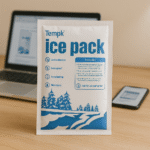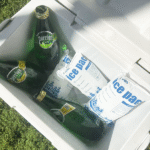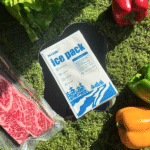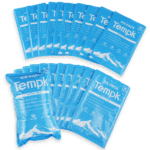How Do Cold Chain Storage Facilities Innovate in 2025?
مقدمة: Cold chain storage facilities are the backbone of modern food and healthcare supply chains. في 2025, the global cold storage market is valued around دولار أمريكي 188.81 مليار and is projected to surpass دولار أمريكي 435 مليار من قبل 2034. في نفس الوقت, consumers increasingly expect fresh, locally sourced foods delivered quickly and safely, while vaccines and biologics demand ultra cold environments. You might be wondering: how do cold chain storage facilities keep up? This article explores the size of the market, emerging technologies, sustainability measures and investment considerations to help you understand—and benefit from—this rapidly evolving industry.

نمو السوق & السائقين: Understand the size of the cold storage market in 2025 and key forces driving growth, including consumer preferences and e commerce.
Facility Design & مناطق درجة الحرارة: Learn what makes a cold chain storage facility distinct from regular warehouses, and how different temperature categories protect various products.
Technology Trends: اكتشف الأتمتة, منظمة العفو الدولية, micro fulfilment hubs and IoT that are transforming operations.
الاستدامة & كفاءة الطاقة: Discover strategies for reducing energy consumption by up to 30 بالمائة and lowering carbon footprints.
Investment Considerations: Evaluate public vs. private warehouses, geographic expansion and costs to help you plan your next project.
الأسئلة المتداولة: Get concise answers to common queries, including how much capacity is needed and what to look for in modern facilities.
What Are Cold Chain Storage Facilities and Why Are They Essential?
إجابة مباشرة: A cold chain storage facility is a temperature controlled warehouse built to maintain precise conditions for perishable goods. Unlike standard logistics warehouses, these facilities preserve everything from frozen foods and fresh produce to vaccines and biologics within strict temperature and humidity ranges. في 2025 the global cold storage market generates roughly دولار أمريكي 188.81 مليار in revenue and grows at about 12 percent per year. Most refrigeration systems in these warehouses account for around 70 percent of total energy consumption, emphasising the importance of advanced insulation and smart monitoring.
شرح موسع: Think of a cold chain warehouse as a giant, multi compartment refrigerator. Some chambers operate below −20 °F for ice cream, others maintain 32–50 °F for fruits and dairy, and specialised areas keep 36–46 °F for pharmaceuticals. The goal is to halt microbial growth, enzymatic spoilage and nutrient loss while ensuring product safety. These facilities are critical because 14 percent of food is lost between post harvest and retail due to poor temperature management. With average cold storage facilities being 42 سنة and more than half over 30 سنين, investing in modern designs with natural refrigerants and IoT enabled monitoring is essential to meet current energy standards and regulatory requirements. الولايات المتحدة. government even classifies cold storage as essential infrastructure, allowing continuous operations during disruptions.
Temperature Zones and Product Categories
Cold chain facilities use different zones to meet diverse product needs. Understanding these zones helps you allocate space efficiently:
| فئة درجة الحرارة | النطاق النموذجي & أمثلة | Practical Importance |
| Deep Freeze | Below –15 °C (5 ° f); used for long term meat storage and ice cream | Requires robust insulation and minimal thermal fluctuation to prevent freezer burn and maintain quality |
| المجمدة | –10 °F to –20 °F (–23 °C to –29 °C); used for meats, fish and prepared meals | Keeps products frozen solid, reducing microbial activity and extending shelf life |
| Chilled/Refrigerated | 32 درجة فهرنهايت إلى 50 ° f (0 درجة مئوية إلى 10 درجة مئوية); used for produce, dairy and beverages | Prevents spoilage while avoiding freezing damage, maintaining freshness |
| الأدوية | 36 درجة فهرنهايت إلى 46 ° f (2 درجة مئوية إلى 8 درجة مئوية); used for vaccines and biologics | Adheres to strict regulatory standards; requires backup power and real time monitoring |
| Cool/Ambient | 8 درجة مئوية إلى 25 درجة مئوية (46 درجة فهرنهايت إلى 77 ° f); used for flowers, snacks and chemicals | Supports less sensitive goods and provides convertible zones for multi temperature warehouses |
نصائح ونصيحة عملية
Understand Your Product Mix: Map your inventory to the correct temperature categories to avoid cross contamination and product spoilage.
Invest in Insulation: ترقية الجدران, roofs and dock seals can save 20–30 percent in energy costs.
Implement Redundancy: Backup compressors and generators ensure temperature stability during power outages.
تدريب الموظفين: Frequent door openings or improper loading compromise temperature integrity; regular training reduces human error.
Real world Case: A large cold chain warehouse in Maryland installed rooftop solar panels on its 268 000 square foot facility, توليد أكثر 2.5 مليون كيلوواط ساعة of renewable energy per year. The on site generation lowered operating costs and improved temperature consistency during peak demand.
How Big Is the Cold Storage Market in 2025 and What Drives Its Growth?
إجابة مباشرة: The cold storage market is expanding rapidly. Precedence Research reports that the global market stands at دولار أمريكي 188.81 مليار في 2025, with projections reaching دولار أمريكي 435.18 مليار من قبل 2034 و 12 معدل نمو سنوي مركب في المئة. Grand View Research estimates a market size of دولار أمريكي 159.7 مليار في 2024, ينمو ل دولار أمريكي 427.6 مليار من قبل 2030 at an 18.1 معدل نمو سنوي مركب في المئة. Research Nester forecasts the market at دولار أمريكي 179.58 مليار في 2025 و دولار أمريكي 204.31 مليار في 2026, with growth expected to exceed دولار أمريكي 745.68 مليار من قبل 2035.
شرح موسع: Several factors are propelling this growth. طلب المستهلكين على الطازجة, healthy and locally sourced food drives the need for refrigerated storage for produce, dairy and proteins. Online grocery sales are projected to account for 21.5 percent of total U.S. grocery sales by 2025, prompting retailers to build micro fulfilment hubs near urban centres. الطعام & beverages segment dominated the market with more than 77 بالمائة شارك في 2024, while frozen products generated 77.95 بالمائة الإيرادات. سمكة, meat and seafood captured 31.69 بالمائة of revenue and dairy accounted for 12.09 بالمائة. On the regional front, North America contributes about 35 بالمائة of revenue and remains the largest market. منطقة آسيا والمحيط الهادئ هي المنطقة الأسرع نموا, expanding at a 10.46 معدل نمو سنوي مركب في المئة. في أثناء, the average facility is ageing—about 42 سنة—and rents have increased 96 percent since 2019, motivating speculative developments and retrofits.
Regional and Segment Highlights
The table below summarises key regional and segment statistics to help you identify high growth areas:
| Segment or Region | Key Statistics & الاتجاهات | تداعيات |
| Private vs. Public Warehouses | Private facilities held 63.65 بالمائة market share in 2024; public warehouses are expanding rapidly, with U.S. public warehouse capacity representing around 71 بالمائة of refrigerated storage. | Owning a facility offers control and value added services; public warehouses enable flexible leasing and scalability. |
| المجمدة مقابل. Chilled Products | The frozen segment generated 77.95 بالمائة من الإيرادات في 2024; chilled and convertible zones are growing for fresh produce and pharmaceuticals. | Frozen foods remain the largest driver, but convertible zones allow facilities to adapt to varied goods. |
| سمكة, لحمة & Seafood vs. ألبان | سمكة, meat and seafood accounted for 31.69 بالمائة الإيرادات, while dairy captured 12.09 بالمائة. | Protein remains a core driver; dairy and processed foods show steady growth and require precise temperature control. |
| North America vs. آسيا والمحيط الهادئ | North America contributed over 35 بالمائة of revenue and is valued at دولار أمريكي 39.6 مليار في 2025. تعد منطقة آسيا والمحيط الهادئ المنطقة الأسرع نموًا حيث يبلغ عددها 10.46 معدل نمو سنوي مركب في المئة. | North America focuses on modernising ageing facilities and meeting e commerce and biopharma demand; Asia Pacific sees rapid new builds and adoption of sustainable technologies. |
| Market Projections | Market size increases from دولار أمريكي 179.58 مليار (2025) ل دولار أمريكي 204.31 مليار (2026) and then to دولار أمريكي 745.68 مليار (2035). | Long term planning must account for capacity expansion, rising construction costs and shifting consumer behaviours. |
Tips for Identifying Growth Opportunities
Assess Regional Demand: North America may offer immediate opportunities for retrofits and micro fulfilment hubs, while Asia Pacific offers new build potential.
Focus on High Growth Segments: Frozen foods and proteins remain dominant; لكن, chilled and pharmaceutical zones are growing and command premium rents.
Monitor E commerce Trends: As online grocery penetration rises toward 21.5 بالمائة بواسطة 2025, demand for last mile cold storage will intensify.
Understand Investor Appetite: Investors are funding speculative builds and upgrades in high growth states such as Texas, Florida and Georgia.
What Emerging Technologies Are Transforming Cold Storage in 2025?
إجابة مباشرة: Cold chain facilities are becoming smarter and more automated. الذكاء الاصطناعي (منظمة العفو الدولية), autonomous mobile robots (مضادات مضادات الميكروبات), أنظمة التخزين والاسترجاع الآلية (AS/RS) and IoT sensors are revolutionising operations. وفقا لأبحاث الأسبقية, AI can monitor temperature, humidity and energy consumption, detect malfunctions like a failing compressor or an open door, and optimise storage layouts based on historical data. The convergence of IoT, AI and advanced analytics enables predictive maintenance, real time temperature monitoring and dynamic routing to reduce handling time and prevent product spoilage.
شرح موسع: The pandemic accelerated automation adoption, و 2025 is witnessing a full blown technology revolution. Post pandemic trends include e grocery growth, micro fulfilment centres, automated picking, mixed pallets automation and mobile manipulators. Key developments expected in 2026 يشمل:
Autonomous Mobile Robots (مضادات مضادات الميكروبات): Self navigating robots that handle repetitive tasks. أمازون, على سبيل المثال, has deployed 750 000 المركبات الموجهة الآلية (AGVs) across its facilities.
Automated Storage & Retrieval Systems (AS/RS): High density systems designed specifically for temperature controlled environments to maximize space.
AI Driven Inventory Management: Predictive analytics allocate storage space, reduce energy consumption and optimise order picking.
Robotic Picking Systems: Advanced manipulators capable of handling frozen and fragile products with precision.
These technologies address labour shortages in harsh environments and improve operational efficiency. AI also helps line operators catch malfunctions before they become costly failures, reducing monetary losses and preserving product quality. Some companies already demonstrate the benefits: Lineage Logistics reduced its annual electricity consumption by 33 مليون كيلوواط ساعة, saving around US$4 million, by integrating AI and wireless sensors in its warehouses.
منظمة العفو الدولية, IoT and Predictive Analytics in Action
To better understand the impact of modern technology, consider how AI, IoT and predictive analytics work together:
| تكنولوجيا | وظيفة | فائدة |
| AI powered monitoring | Uses machine learning to track temperature, humidity and energy consumption; detects malfunctions such as open doors or failing compressors | Minimises product spoilage and reduces energy waste by catching issues before they cause damage. |
| مستشعرات إنترنت الأشياء | Provide real time data on temperatures and inventory status | Ensures compliance with regulatory requirements and product quality; facilitates end to end visibility. |
| التحليلات التنبؤية | Analyses historical data to optimise storage allocation, order picking and energy use | يزيد من الإنتاجية, improves space utilisation and lowers electricity costs. |
| التوجيه الديناميكي | Utilises data on traffic and weather to plan efficient shipping routes | يقلل من وقت العبور, preserves product quality and decreases fuel consumption. |
| Robotics and AS/RS | Automate picking and storage in harsh environments | Address labour shortages, improve accuracy and enable high density storage. |
Practical Tips for Adopting New Technologies
Start with Sensors: Deploy IoT sensors to monitor temperature and humidity. Data provides the foundation for AI and predictive analytics.
Evaluate Robotics ROI: Consider AMRs and AS/RS where labour costs are high or picking accuracy is critical. Pilot projects can illustrate ROI before full scale deployment.
Leverage Predictive Maintenance: Use AI to anticipate equipment failures; this reduces downtime and maintenance costs.
Integrate Systems: Ensure new technologies integrate with existing warehouse management systems to provide unified visibility.
دراسة حالة: A case study by Cold Summit demonstrated that their proprietary refrigeration design achieved a 62 percent reduction in electricity usage compared to legacy freon systems and delivered a 30 percent improvement over modern ammonia and freon systems. Even against advanced CO₂ cascade systems, their design offered an additional 5.2 بالمائة توفير الطاقة. At an average industrial electricity rate of $0.075 per kWh, these savings translate to roughly $750 000 in annual cost reductions and avoid more than 4 000 metric tons of CO₂ emissions—equivalent to removing nearly 1 000 gasoline powered vehicles.
How Do Sustainability and Energy Efficiency Impact Cold Storage?
إجابة مباشرة: Energy efficiency and sustainability are now core business strategies. Advanced insulation technologies can reduce energy consumption by 20–30 percent. Facilities are adopting natural refrigerants to replace traditional systems, integrating solar and renewable energy and using smart building management systems to optimise temperature control. Refrigeration systems still account for about 70 بالمائة of energy use in cold warehouses, making improvements crucial.
شرح موسع: As energy costs rise and environmental regulations tighten, operators need greener solutions. Modern warehouses incorporate high performance insulation, vapor barriers and upgraded dock seals to minimize heat transfer. Natural refrigerants such as ammonia and CO₂ reduce greenhouse gas emissions and meet emerging regulatory standards. Fuel cell based forklift technology, which uses hydrogen rather than batteries, can free up over 60 بالمائة of space previously used for charging stations and boost warehouse productivity by up to 15 بالمائة. Many companies install rooftop solar or integrate renewable energy; على سبيل المثال, a Maryland facility generates 2.5 مليون كيلوواط ساعة annually from solar panels. By combining these technologies, cold storage operators not only reduce carbon footprints but also realise significant cost savings.
Energy Efficiency Strategies and Benefits
| استراتيجية | وصف | Business Benefit |
| العزل المتقدم & Vapor Barriers | High performance walls, roofs and floors reduce heat gain; upgraded doors and dock seals minimise air leakage | Cuts energy consumption by 20–30 percent and reduces operating costs |
| Natural Refrigerants | Ammonia or CO₂ systems replace hydrofluorocarbons and freon | Lower greenhouse gas emissions; align with regulations and qualify for incentives |
| Renewable Energy Integration | Rooftop solar panels or wind turbines provide on site energy | Reduces electricity bills and ensures energy availability during peak demand |
| Fuel Cell Technology | Hydrogen powered forklifts free up space and improve efficiency | Saves warehouse floor space (زيادة 60 بالمائة compared to battery charging) and increases productivity by 15 بالمائة |
| Smart Building Management Systems | IoT sensors and AI algorithms optimise temperature settings and schedule equipment maintenance | Prevents energy waste, reduces equipment downtime and ensures compliance |
| الصيانة التنبؤية | AI based algorithms detect potential failures before they occur | Minimises downtime, prevents product loss and avoids costly repairs |
Tips for Implementing Sustainable Practices
Conduct an Energy Audit: Identify where energy is wasted and prioritise upgrades in insulation, lighting and refrigeration equipment.
Switch to Natural Refrigerants: Evaluate ammonia or CO₂ systems and ensure staff receive proper training.
Integrate Renewable Energy: Explore solar or wind solutions; many facilities can offset a significant portion of their energy consumption.
Adopt Fuel Cell Forklifts: Free up valuable warehouse space and improve throughput. Collaborate with hydrogen suppliers to ensure reliable refuelling.
Use Smart Controls: Implement building management systems and remote monitoring to adjust temperatures dynamically and avoid overshooting set points.
Energy Comparison: The following visualisation illustrates relative energy consumption of different refrigeration systems—legacy freon, modern ammonia/freon, advanced CO₂ cascade and a cutting edge design used by Cold Summit. Energy consumption is indexed, مع 100 representing legacy systems. Notice how Cold Summit’s design reduces energy use dramatically.
What Challenges and Considerations Should You Know When Investing in Cold Storage Facilities?
إجابة مباشرة: Investing in cold storage is capital intensive. High initial costs for construction, refrigeration equipment and insulation are among the main barriers to entry. Power outages and electricity fluctuations can disrupt cooling systems, leading to product spoilage. Facility owners must also decide between public and private warehouses—private facilities offer control and value added services, while public warehouses provide flexible leasing options.
شرح موسع: Modernising or building a cold chain facility involves significant planning. Besides the cost of construction and equipment, developers must secure land with sufficient power supply and appropriate zoning. الولايات المتحدة. alone will require an additional 1 billion square feet of warehouse space by 2025, أو أكثر 50 000 new warehouses will be needed in the next six years. High growth states such as Texas, Florida and Georgia account for 47 بالمائة of new developments since 2020. Rents have risen 96 بالمائة منذ 2019, making speculative construction attractive. لكن, retrofitting older facilities often requires substantial investment to improve insulation, refrigeration and automation.
3رر (third party logistics) operators often struggle with one size fits all warehouses because customers request bespoke temperature settings and handling services. Many 3PLs are building specialised facilities tailored to client needs, but locking price sensitive customers into long term contracts can be risky. علاوة على ذلك, the shortage of industrial land in urban cores pushes operators toward suburban locations, where they must navigate zoning and power supply constraints.
Public vs. Private Warehouses: إيجابيات وسلبيات
Private Warehouses: Provide total control over temperature, operations and value added services, enabling custom solutions for high margin clients. لكن, they require substantial upfront investment and may sit idle during demand fluctuations.
Public Warehouses: Offer flexible leasing arrangements and reduce capital requirements. في الولايات المتحدة, public warehouses account for 71 بالمائة of refrigerated storage capacity. They suit businesses that need scalable capacity but may lack specialized services.
النهج الهجين: Some operators build flexible facilities that combine private zones with shared public spaces, enabling efficiency while capturing premium rents.
Tips for Prospective Investors
Perform a Feasibility Study: Analyse regional demand, energy costs, incentive programmes and regulatory requirements before committing to a project.
Prioritise Location: Proximity to customers reduces transportation costs and energy use; ensure power infrastructure can handle refrigeration loads.
Plan for Scalability: Design facilities with modular cold rooms and convertible zones so that temperature settings can be adjusted without major renovations.
Consider Micro Fulfilment Hubs: For urban markets, smaller facilities near population centres shorten last mile delivery times and support e commerce growth.
Leverage Speculative Development: In high growth regions, speculative builds—where facilities are constructed without a specific tenant—can attract premium leases and capitalise on rising rents.
Interactive Self Assessment: To determine whether you should invest in a private or public cold storage facility, أجب عن الأسئلة التالية:
- Do you need full control over temperature zones and value added services? – إذا كانت الإجابة بنعم, a private facility may be suitable. – If no, consider a public or hybrid facility. 2. Can you commit substantial capital up front and tolerate periods of low utilisation? – إذا كانت الإجابة بنعم, private ownership could yield long term returns. – If no, a public warehouse offers lower risk. 3. Are your customers’ needs highly specialised or varied? – If specialised, a custom build may be necessary. – If varied, choose a flexible facility with modular zones. 4. What is your target region’s growth rate? – High growth regions justify speculative developments; mature markets may require retrofits and efficiency upgrades.
Latest Trends and Predictions for 2025 وما بعدها
نظرة عامة على الاتجاه: The cold storage industry is entering a period of unprecedented transformation. وفقا ل 2025 industry outlook, the following trends will define the landscape:
Automation Revolution: Adoption of AMRs, AS/RS, AI driven inventory management and robotic picking is reshaping operations.
Urban Micro Fulfilment: Online grocery growth prompts retailers to retrofit or build small hubs within city cores, offering multi temperature zones and click and collect services.
Capacity Expansion: الولايات المتحدة. alone needs an additional 1 billion square feet of warehouse space by 2025; تقريبا 50 000 new warehouses will be required over the next six years.
كفاءة الطاقة & الاستدامة: Operators adopt advanced insulation, المبردات الطبيعية, renewable energy and smart management systems to reduce energy use by 20–30 percent.
Smart Facilities: The convergence of IoT, AI and analytics delivers predictive maintenance, real time temperature monitoring and integrated supply chain visibility.
آخر تقدم في لمحة
Automation Adoption: Large operators are deploying hundreds of thousands of AGVs and robots to handle picking and storage tasks.
Micro Fulfilment Growth: Online grocery sales are expected to reach 21.5 بالمائة من الولايات المتحدة. grocery sales by 2025, driving demand for small urban facilities.
Green Refrigeration: Natural refrigerants and CO₂ cascade systems replace hydrofluorocarbons, while solar integration and energy efficient materials reduce operational costs.
Data Driven Operations: Predictive maintenance and AI driven inventory systems are now standard in leading facilities.
استثمار & سعة: Rising rents and ageing infrastructure push investors toward speculative construction and retrofits.
رؤى السوق: Despite economic uncertainties, the cold storage industry’s long term prospects remain strong. Increased trade of perishable goods and global free trade agreements drive demand. Growing health consciousness fuels consumption of proteins, الفواكه والخضروات, which depend on cold storage to preserve nutrients. في أثناء, the expansion of organised retail—including supermarkets, hypermarkets and convenience stores—continues to boost demand. On the technology front, AI powered systems are optimizing warehouse layouts, reducing energy waste and improving throughput.
الأسئلة المتداولة
س 1: What capacity growth should companies plan for between 2025 و 2030?
Companies should anticipate rapid expansion. The cold storage market is projected to grow from about دولار أمريكي 188.81 مليار في 2025 لأكثر من دولار أمريكي 427 مليار من قبل 2030. الولايات المتحدة. alone may require an additional 1 billion square feet of warehouse space by 2025.
Q2: How do micro fulfilment centres improve cold chain efficiency?
Micro fulfilment centres are compact warehouses located near urban populations. They shorten last mile lead times and support online grocery demand. Many facilities use multiple temperature zones and integrate automated sorting and click and collect systems.
س 3: What percentage of energy consumption comes from refrigeration equipment?
Refrigeration accounts for roughly 70 بالمائة of total energy use in cold chain warehouses. Upgrading insulation and adopting natural refrigerants can cut consumption by 20–30 percent.
س 4: Are public warehouses sufficient for pharmaceutical storage?
Public warehouses can meet many pharmaceutical needs, but they must comply with strict temperature and monitoring regulations. When high value biologics are involved, private or hybrid facilities may provide better control and redundancy.
اقتراح
النقاط الرئيسية: The cold storage market is booming and will more than double by the early 2030s, driven by consumer demand for fresh food, online grocery growth and pharmaceutical needs. North America remains the largest market while Asia Pacific is the fastest growing. Modern facilities must adopt automation, منظمة العفو الدولية, micro fulfilment strategies and renewable energy to stay competitive. Energy efficiency is critical; refrigeration consumes about 70 بالمائة of total energy, but insulation and smart systems can reduce usage by 30 بالمائة. Investing in sustainable technology not only cuts costs but also reduces carbon footprints.
توصيات قابلة للتنفيذ:
Conduct Comprehensive Audits: Assess current energy consumption, insulation quality and refrigeration equipment. Use the findings to prioritise upgrades.
Adopt Automation Strategically: تنفيذ أجهزة استشعار إنترنت الأشياء, AI and robotics to improve efficiency and reduce labour costs.
Plan for Flexible Capacity: Use modular cold rooms and convertible zones to adapt to changing product mixes and customer requirements.
Pursue Sustainable Practices: Integrate renewable energy, natural refrigerants and fuel cell technology to cut energy bills and meet regulatory demands.
Prepare for Growth: Build or retrofit facilities with future capacity in mind, considering both regional demand and technological advancement.
حول Tempk
Tempk develops innovative cold chain packaging, storage and logistics solutions. نحن نجمع research driven engineering مع practical expertise to help clients deliver food, المستحضرات الصيدلانية والبيولوجية بأمان وكفاءة. Our products—ranging from insulated boxes and ice packs to state of the art cold rooms—are designed for إعادة الاستخدام, الأداء الحراري و الامتثال التنظيمي. نحن نستثمر بكثافة في R&D and collaborate with industry partners to pioneer sustainable materials and advanced monitoring systems. و Tempk, we believe that preserving quality and reducing waste is not just good business—it’s a responsibility to our clients and the planet.
Ready to future proof your cold chain? Contact our experts today to discuss custom solutions and discover how Tempk can help you build or retrofit energy efficient, high performance cold storage facilities.























